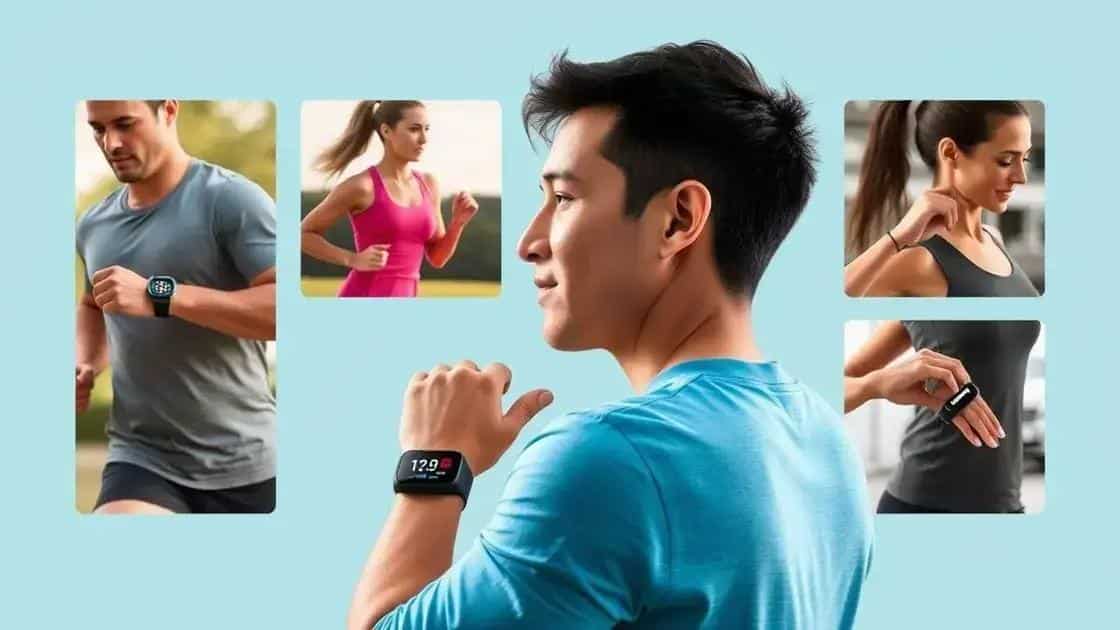Wearable tech innovation trends to watch in 2024

Wearable tech innovations significantly enhance health management, offering real-time monitoring, personalized insights, and integration with advanced health systems to improve overall fitness and user experience.
Wearable tech innovation trends are rapidly changing how we interact with technology in our everyday lives. Have you ever wondered how these devices can enhance your health and fitness? Let’s dive into these exciting developments.
Current wearable tech advancements
The world of wearable tech innovations is advancing at lightning speed. These devices play a crucial role in modern life, improving health and enhancing connectivity.
Key Advances in Wearable Technology
Recently, several breakthroughs have emerged in this field, creating exciting opportunities for users.
- Smartwatches: These devices are now equipped with advanced health monitoring capabilities, such as heart rate tracking and blood oxygen levels.
- Fitness Trackers: They help users maintain active lifestyles by monitoring daily activities and providing valuable insights.
- Augmented Reality (AR): Wearable AR technology is changing the way we experience everyday activities, from gaming to navigation.
- Medical Devices: New wearables are being used to manage chronic conditions, allowing for remote monitoring and timely intervention.
These advancements not only enhance how individuals engage with technology but also improve overall health outcomes. The integration of AI in wearables is a game changer. AI algorithms help analyze health data, making recommendations tailored to the user’s habits.
Another essential aspect is the increased focus on user privacy. As more sensitive health data is collected, companies are implementing robust security measures to protect user information.
Wearables in Everyday Life
Imagine waking up and checking your smartwatch for a detailed report of your sleep quality. This immediate feedback allows you to adjust your lifestyle for better rest. Moreover, fitness trackers provide real-time feedback during workouts, which keeps motivation high and encourages users to reach their goals.
With the rise of telehealth, remote monitoring through wearables has surged. This trend is especially advantageous for elderly patients and those in remote areas, as it enables healthcare providers to keep a close watch on vital signs from afar.
As we look toward the future, the potential for wearable technology is limitless. Innovations continue to emerge, promising even more capabilities that blend technology seamlessly into our daily lives. Embracing these developments can lead to improved health, better connectivity, and an enhanced overall experience.
Health benefits of wearable devices

Wearable devices offer a range of health benefits that can greatly enhance your lifestyle. From fitness tracking to medical monitoring, these technologies are transforming how we manage our health.
Key Health Benefits of Wearable Devices
These devices are not only convenient but also contribute significantly to our well-being.
- Real-time health monitoring: Wearables allow users to track vital signs like heart rate, sleep patterns, and activity levels.
- Motivation and accountability: Many devices come with features that encourage regular exercise and healthy habits.
- Chronic disease management: Wearables can help individuals manage conditions like diabetes by providing constant monitoring of blood glucose levels.
- Data collection for better care: Health data collected by wearables can be shared with healthcare providers for informed decision-making.
The impact of wearable devices extends beyond simple fitness and activity tracking. For instance, many smartwatches have built-in sensors that can detect irregular heartbeats. This feature can alert users to potential heart problems, prompting them to seek medical advice sooner.
With features like medication reminders and activity alerts, these devices help users adhere to their health plans. Additionally, integrating wearables with mobile health apps can create a comprehensive picture of a user’s health status.
Improved Mental Health
Wearables also play a role in supporting mental health. Many devices offer mindfulness and relaxation features, such as guided breathing exercises and stress tracking. These tools can help users manage anxiety and promote overall emotional well-being.
Furthermore, connecting with community features on apps can provide social support, which is vital for mental health. Users can join challenges or support groups, creating a sense of community that encourages healthy behaviors.
Overall, the benefits of wearable devices are profound. As technology continues to evolve, these devices will likely provide even more opportunities for enhancing personal health and well-being.
The impact of wearable tech on fitness
Wearable tech has a significant impact on fitness, transforming how people approach their health and exercise routines. These devices help users monitor their performance and achieve their fitness goals.
Enhanced Workout Tracking
Fitness wearables, such as smartwatches and fitness bands, provide real-time data during workouts. This allows users to understand their heart rates, calories burned, and distance covered. Such information can make a big difference in tailoring exercise regimens.
- Accuracy in tracking: Modern devices utilize GPS and heart rate sensors to deliver precise data.
- Goal setting: Many wearables allow users to set specific fitness goals, helping to keep them motivated.
- Feedback and insights: These devices analyze workout patterns, offering personalized suggestions for improvement.
- Compatibility with apps: Most fitness wearables connect with various health apps to provide deeper insights.
By gathering data over time, users can spot trends and adjust their workouts to meet their objectives effectively. This ongoing performance analysis encourages consistency and progression, which are vital for reaching fitness milestones.
The Motivational Aspect
Wearable tech also serves as a motivational tool. Many devices send reminders to move and celebrate achievements, big or small, amplifying user engagement.
Social features foster competition and community among friends or family. Many users enjoy participating in challenges, sharing results, and encouraging one another, making fitness a more enjoyable experience.
Additionally, wearable devices often feature gamified elements, turning exercise into a fun activity. Completing daily steps or exercising for specific periods can earn users rewards, igniting a desire to stay active.
As more individuals embrace wearable tech, the overall fitness landscape is shifting. These devices are not merely gadgets; they shape the way people engage with their health, leading to healthier lifestyles and improved physical fitness.
Future predictions for wearable technology

The future of wearable technology is promising, with numerous predictions that suggest how these devices will evolve. As technology advances, we can expect significant changes that will enhance user experience and health benefits.
Integration with Advanced Health Monitoring
One of the key trends is the deeper integration of wearables with advanced health monitoring systems. This includes features like continuous glucose monitoring, blood pressure tracking, and even early disease detection.
- Smart fabric sensors: Future wearables may use smart fabrics that can monitor vital signs directly on the skin.
- AI-driven health insights: With artificial intelligence, wearables can provide personalized health advice based on real-time data.
- Multi-functionality: Expect devices that combine fitness tracking, health monitoring, and smart home control all in one.
- Telehealth integration: Wearables will seamlessly connect users to healthcare providers for remote check-ups and consultations.
This expansion into comprehensive health tracking could revolutionize preventive care, enabling users to take charge of their health proactively. By using data analytics, wearables will anticipate issues before they become serious health concerns.
Enhanced User Experience and Interactivity
Another important trend is the enhancement of user experience through more interactive and user-friendly interfaces. Future wearables will likely feature more intuitive controls, such as voice commands and touch-based gestures, making them easier to use while on the go.
Moreover, augmented reality (AR) integration is expected to become mainstream. This technology can provide users with real-time information overlay, enhancing activities like exercising, where users could see metrics overlaid in their field of vision.
With these developments, wearables will become even more embedded in daily life, making health management a seamless part of everyday routines, rather than a separate task. As technology continually evolves, the possibilities seem limitless.
Additionally, privacy and data security will continue to be major focuses for developers. Future wearables will likely come equipped with advanced security features to protect users’ health data, addressing growing concerns about data breaches.
Wearable technology is changing the way we live and manage our health. As these devices continue to evolve, they will provide even more benefits and features. With advancements in health monitoring, user experience, and security, wearables will become essential tools for fitness and health management. Embracing these innovations can help individuals take proactive steps toward better health and a more connected life. The future looks bright for wearable technology!
FAQ – Frequently Asked Questions About Wearable Technology
What are the main health benefits of wearable devices?
Wearable devices offer health benefits such as real-time health monitoring, fitness tracking, and personalized health insights.
How will wearable technology evolve in the future?
Future wearable tech is expected to integrate advanced health monitoring, AI-driven insights, and enhanced user experiences.
Can wearable devices help with chronic disease management?
Yes, many wearables are designed to help manage chronic diseases by monitoring vital signs and providing data for better care.
Are privacy and data security concerns addressed in wearable tech?
Absolutely! Developers are focusing on improving security features to protect user data from breaches and ensure privacy.





